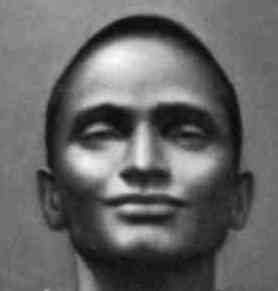Gurus & Saints of India
Bhagwana Nityanand

Childhood
Details about Nityananda's birth are sketchy but most accounts agree that Nityananda's mother abandoned him as an infant. He was found/adopted by a woman who worked as a maid working as a servants for Mr. Ishwar Iyer, a lawyer. Upon the woman's death Mr. Iyer adopted Nityananda (then known as Ram). Even in childhood, Nityananda seemed to be in an unusually advanced spiritual state, which gave rise to the belief that he was born enlightened. He was eventually given the name Nityananda: "always in bliss".
Before the age of twenty, Nityananda became a wandering yogi, spending time on yogic studies and practices in the Himalayas and other places. By 1920 he was back in southern India, where he had a fleeting encounter with a boy who would later become Swami Muktananda.
Adult life
Settled in southern India, Nityananda gained a reputation for affecting miracles and wonderful cures. He then started building an ashram near Kanhangad, Kerala state. The local police thought he must be producing counterfeit money to pay for the building, so Nityananda took them to a crocodile-infested pool in the jungle. He dived in and then produced handfuls of money, which was apparently enough to satisfy the police.
By 1923, Nityananda had wandered to the Tansa Valley in Maharashtra state. There, his reputation as a miracle worker attracted people from as far away as Mumbai, though he never claimed credit for any miracles. He said, "Everything that happens, happens automatically by the will of god Nityananda gave a great deal of help to the local adivasis, who were despised by the population at large. Nityananda set up a school for them, as well as providing food and clothing.
As a guru, Nityananda gave relatively little by way of verbal teachings. Starting in the early 1920s, devotees would sit with him in the evenings. Most of the time he was silent but occasionally he would give teachings. Some of the devotees starting writing down his words. Later these notes were compiled and published in the Kannada language.
Nityananda had the power to transmit spiritual energy (shaktipat) to people through non-verbal means. He could also be extremely fiery and intimidating in his behaviour, even to the point of throwing rocks on occasion. This was his way of deterring people who were not serious in their spiritual aspirations, or who came to him with ulterior motives.
In 1936 he went to the Shiva temple in the village of Ganeshpuri and asked if he could stay there. The family that looked after the temple agreed and built a hut for him. As his visitors and followers increased, the hut expanded and became an ashram. To the people around him, he was an avadhuta: one who is absorbed in the transcendental state.
Nityananda died on August 8, 1961. There is a shrine to him in the Gurudev Siddha Peeth ashram at Ganeshpuri. His ashram, tourist hostel and other buildings associated with his life in Ganeshpuri are preserved by the Shree Bhimeshwar Sadguru Nityanand Sanstha Ganeshpuri. This trust is also responsible for his samadhi shrine in Ganeshpuri, which is a pilgrimage site.
Nityananda’s Guru
According to Nityananda's biographers, the identity of Nityananda's guru is a mystery. Some believe that he had no guru. In one of his talks, Swami Muktananda said Nityananda’s Guru was an unknown Siddha Purusha from Kerala.